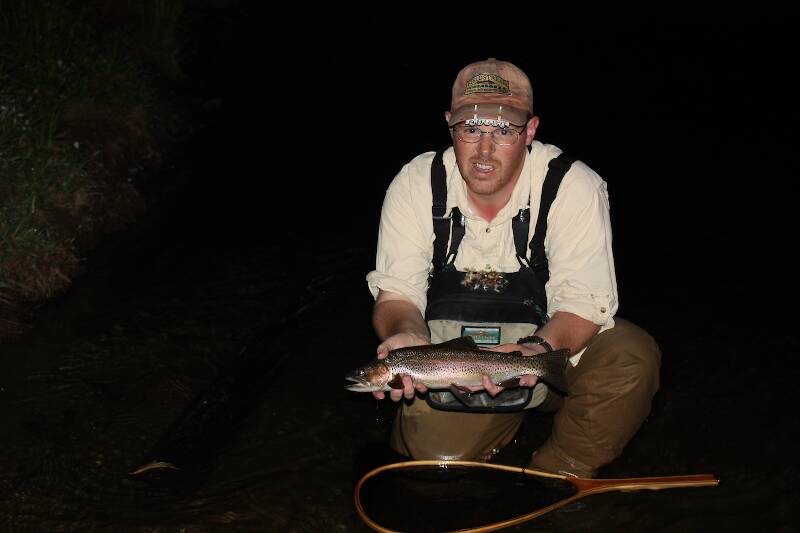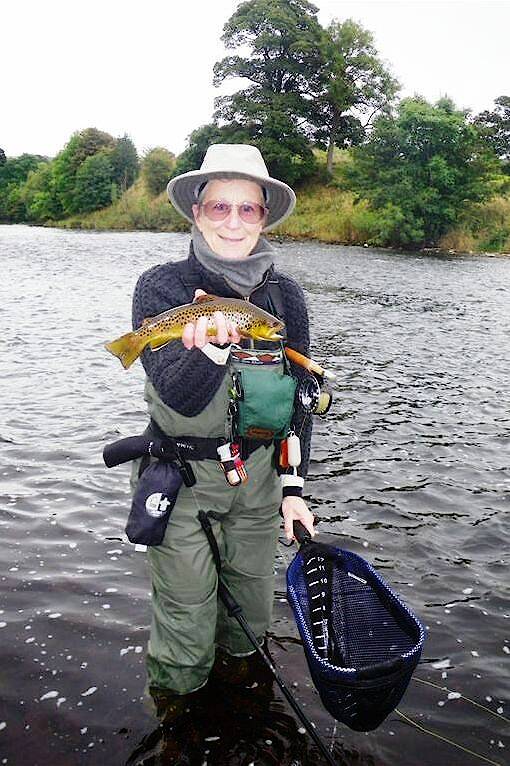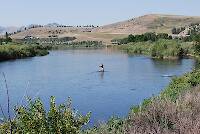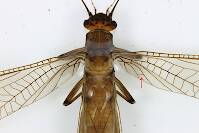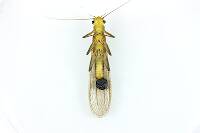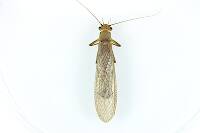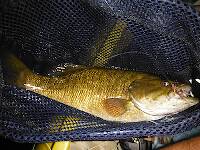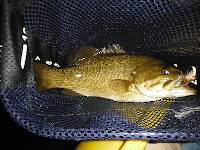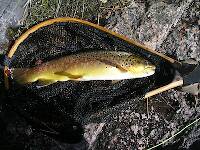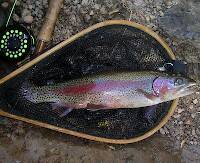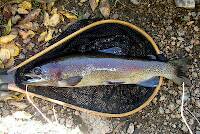
Hex Mayflies
Hexagenia limbata
The famous nocturnal Hex hatch of the Midwest (and a few other lucky locations) stirs to the surface mythically large brown trout that only touch streamers for the rest of the year.
Featured on the forum

This one pretty clearly keys to Kogotus, but it also looks fairly different from specimens I caught in the same creek about a month later in the year. With only one species of the genus known in Washington, I'm not sure about the answer to this ID.

Troutnut is a project started in 2003 by salmonid ecologist Jason "Troutnut" Neuswanger to help anglers and
fly tyers unabashedly embrace the entomological side of the sport. Learn more about Troutnut or
support the project for an enhanced experience here.
GONZO on Jul 17, 2007July 17th, 2007, 12:00 pm EDT
This thread is for my good friend, Louis. For those who have been following, you know that Louis has been trying to find ways to see in the dark and ways to have better retention of the fish he hooks. You also know that I have teased him mercilessly about both of these quests. I was skeptical about the "glow-in-the-dark" thing, but he seems to have found some answers despite my heckling (hectoring?). With regard to the retention quest, I think you'd agree that the research and testing Louis did on the topics of leaders, tippets, and knots has educated and benefited us all. (This, again, despite my playing the role of kibitzer.)
But attempting to solve the retention problem involves much more than just good tippets and strong knots. Louis knows this, of course, and I just wanted to take a few moments to look at the less tangible side of the retention equation. The following thoughts address some of the things that influence our success in retaining fish once they are hooked, but many of these influences are only partly under our control.
Fishing partners and other distractions: This may seem like a strange place to start, but I'm sure I'm not the only one who often catches and lands more fish when fishing alone. (Please, no cheap shots like "Sure, that's because there's no one to verify it, and you can claim to have caught or landed whatever you want!" Despite the obvious truth in that statement, I'm trying to be serious--for the moment.)
When fishing alone, all of the shots at fish are mine, as is the pace and the approach, so it's not unusual that I often catch twice as many fish as when fishing the same stretch with a partner. When fishing with a partner (and here I mean fishing with a partner, not just fishing the same stream), the shots are divided and compromises are often made in pace and approach. Now, this really doesn't affect hooking/landing much, but it can influence the perception of success. If you hook 20 and land 10 fishing alone, you feel (and are) more successful than when you hook 10 and land 5 fishing with a partner--but the ratio is the same.
The more significant influence is just the comraderie of fishing with a friend. Of course, this is one of the main reasons for fishing with a partner. But, unless that partner is the fishing equivalent of Silent Bob, the conversation/competition can interfere with optimum performance. How many times have you looked at the fish your friend is fighting only to blow the response to a take of your own? Or tried to answer a question or make a comment at the critical moment when you should have had a laserlike focus on your line/fly? Friends are not the only sources of distraction that cause us to make ineffectual hook-ups, but they are often the hardest to ignore. I've mentioned the "distraction factor" before, but I am continually amazed at how often fish seem to take at the moment when we are least prepared. (How do they know?)
Timing and touch: Knowing when and how to set the hook in various situations is often one of the most critical factors in retention. Experience alone seems the only sufficient way to train and hone these reactions, but even very experienced anglers can overreact or underreact or react in the wrong way at times. Sometimes we recognize our mistake, but it is usually too late--the deed is done and we must live with the consequences.
Shawn could tell you that during our recent trib-fishing excursion, the rise-to-landing ratio was extremely low for both of us, despite having lots of good action from the fish. Some of this was attributable to rises that were really refusals. (Yes, recent pressure can cause refusals even on tiny waters where the fish are usually eager takers of the fly). Some was undoubtedly due to my incessant chatter--that comraderie thing. And some was due to the need to temper our response to the take. If you don't control your reactions on tiny waters, you end up flinging a lot of small fish into the air. Sometimes that happens even when you do try to exercise control. But the tentative second guessing can also cause bad hook-ups with better fish. Once, I was demonstrating an approach/delivery that I thought might be more effective, and sure enough, the fish responded on cue. I, however, experienced an inexplicable paralysis of the wrist as the fish slowly came up and took my fly--I did nothing! I may have been surprised that the fish actually cooperated with my little demo (because they rarely go out of their way to make me look good), but I felt like an idiot. Timing and touch are essential in order to have any hope of consistently landing fish.
The bad move: Sometimes the reasons for loss are more about what happens after the hook-up than the quality of the hook-up itself. Bad habits, poor planning, or impatience are the biggest factors in producing the bad move. Low lateral rod angles are often the best for fighting fish, but many of us automatically resort to lifting the rod to the sky during the fight. Not only does this limit the effective pressure we can put on the fish, but it means that the fish can have more control over the situation. We open up the options for the fish with a high rod, allowing it to wallow or maneuver in ways that it couldn't under the lateral pull of a low rod.
Poor planning contributes to our losses when we don't consider our options before we hook the best fish of the hole. Fish that reach cover or bolt downstream are often lost. Sometimes this is unavoidable, but at other times, having a game plan can give us an edge. Thinking about our fighting position rather than just our fishing position can make a difference. Many times I have done everything right from the standpoint of getting the fish to take and hooking it, only to find myself dealing with the old question, "Now that you've got it, what are you going to do with it?" Without a good plan for fighting a big fish, the answer is often "Lose it!"
Impatience is probably the prime cause of the bad move. Often this happens just as the fish seems to be within our grasp. A sudden surge, a little slip, a tad too much pressure, and the fish is gone. Everyone knows that sinking feeling of having been so close and yet so far. Yes, we should fight the fish with everything we have and bring it in as soon as possible, but just when the battle seems to be won is not the time to get impatient. When the fish is close, much of our margin for error is lost. The rod is bent to the max, the leader knot is often inside the guides, and whatever abrasion/weakening of tippet and knot has occurred during the fight is at its most critical. Patience is hard to exercise when the prize is so close.
The long/slack line: For those who can throw and work a long line, sometimes the temptation is irresistible. Yet we all know that the longer the line, the lower the chances of getting a good hook-up (or controlling the fish). Sometimes the gamble is worth it, but if we are throwing a long line just because we can (as opposed to it being the only option), we are just asking for trouble. How many times could we have moved our feet closer rather than casting farther? And how many times have we paid the price for that laziness?
Slack is often a factor in failure to hook fish on a long line, but it is worth considering even at shorter distances. Sometimes the very slack we need to properly present the fly works against us when the fish takes. My one-armed fishing partner could tell you all about this. He has far fewer options for controlling/gathering slack than most of us, and most of his failures to hook and land fish are all about slack. In his case this is quite understandable, and he has come to accept this as part of the game. (Usually.) But when the same thing happens to me, I often find myself asking, "OK, Gonzo, what's your excuse?"
Commitment vs. involvement: There's a folksy little saying about the difference between commitment and involvement that is often told over the breakfast table. The chicken that laid the eggs, the saying goes, was involved in my breakfast, but the pig that made the bacon was committed. I think this often applies to the way fish take our flies, and it bears directly on the nature of our hook-ups. Fish that are truly committed to the fly are easy to hook solidly and are consequently more likely to be landed. Fish that are merely involved with the fly, on the other hand, are often poorly hooked (if at all) and stand a good chance of getting off.
Once, I was fishing my favorite Drunella hatch on one of my favorite streams, and the wild browns were so committed to the fly that I considered quitting for the day. They were taking it so solidly and deeply that I worried about doing them some harm. Every fish that rose to the fly was hooked and all were landed. On other occasions, the fish's involvement with the fly seemed so tentative that getting a good hook-up was almost impossible, and most fish that did get hooked were lost. Whenever I am fishing over extremely pressured fish that are going through their inspecting/testing/tasting routine, I would like to hook and land every fish that takes my fly, but I know from experience that the expectation is entirely unreasonable.
Damned fish flesh: This is perhaps the inescapable bottom line in fish retention. No matter what else we may do right or wrong, fish flesh is the weak link in the chain that leads from hook-up to hand. Until we devise a laser-guided hook that unerringly finds the toughest part of a fish's mouth, a few pull-outs will be inevitable. And because big fish pull harder on that same weak flesh, many of those pull-outs will be on the biggest fish we hook. Sad, but true. I sometimes kid my fishing partner after a pull-out by saying that he needs to start "aiming for the bone." The look he gives me in response says it all when it comes to solving this eternal problem. Sometimes the spirit is willing but the flesh is weak!
-Gonzo
But attempting to solve the retention problem involves much more than just good tippets and strong knots. Louis knows this, of course, and I just wanted to take a few moments to look at the less tangible side of the retention equation. The following thoughts address some of the things that influence our success in retaining fish once they are hooked, but many of these influences are only partly under our control.
Fishing partners and other distractions: This may seem like a strange place to start, but I'm sure I'm not the only one who often catches and lands more fish when fishing alone. (Please, no cheap shots like "Sure, that's because there's no one to verify it, and you can claim to have caught or landed whatever you want!" Despite the obvious truth in that statement, I'm trying to be serious--for the moment.)
When fishing alone, all of the shots at fish are mine, as is the pace and the approach, so it's not unusual that I often catch twice as many fish as when fishing the same stretch with a partner. When fishing with a partner (and here I mean fishing with a partner, not just fishing the same stream), the shots are divided and compromises are often made in pace and approach. Now, this really doesn't affect hooking/landing much, but it can influence the perception of success. If you hook 20 and land 10 fishing alone, you feel (and are) more successful than when you hook 10 and land 5 fishing with a partner--but the ratio is the same.
The more significant influence is just the comraderie of fishing with a friend. Of course, this is one of the main reasons for fishing with a partner. But, unless that partner is the fishing equivalent of Silent Bob, the conversation/competition can interfere with optimum performance. How many times have you looked at the fish your friend is fighting only to blow the response to a take of your own? Or tried to answer a question or make a comment at the critical moment when you should have had a laserlike focus on your line/fly? Friends are not the only sources of distraction that cause us to make ineffectual hook-ups, but they are often the hardest to ignore. I've mentioned the "distraction factor" before, but I am continually amazed at how often fish seem to take at the moment when we are least prepared. (How do they know?)
Timing and touch: Knowing when and how to set the hook in various situations is often one of the most critical factors in retention. Experience alone seems the only sufficient way to train and hone these reactions, but even very experienced anglers can overreact or underreact or react in the wrong way at times. Sometimes we recognize our mistake, but it is usually too late--the deed is done and we must live with the consequences.
Shawn could tell you that during our recent trib-fishing excursion, the rise-to-landing ratio was extremely low for both of us, despite having lots of good action from the fish. Some of this was attributable to rises that were really refusals. (Yes, recent pressure can cause refusals even on tiny waters where the fish are usually eager takers of the fly). Some was undoubtedly due to my incessant chatter--that comraderie thing. And some was due to the need to temper our response to the take. If you don't control your reactions on tiny waters, you end up flinging a lot of small fish into the air. Sometimes that happens even when you do try to exercise control. But the tentative second guessing can also cause bad hook-ups with better fish. Once, I was demonstrating an approach/delivery that I thought might be more effective, and sure enough, the fish responded on cue. I, however, experienced an inexplicable paralysis of the wrist as the fish slowly came up and took my fly--I did nothing! I may have been surprised that the fish actually cooperated with my little demo (because they rarely go out of their way to make me look good), but I felt like an idiot. Timing and touch are essential in order to have any hope of consistently landing fish.
The bad move: Sometimes the reasons for loss are more about what happens after the hook-up than the quality of the hook-up itself. Bad habits, poor planning, or impatience are the biggest factors in producing the bad move. Low lateral rod angles are often the best for fighting fish, but many of us automatically resort to lifting the rod to the sky during the fight. Not only does this limit the effective pressure we can put on the fish, but it means that the fish can have more control over the situation. We open up the options for the fish with a high rod, allowing it to wallow or maneuver in ways that it couldn't under the lateral pull of a low rod.
Poor planning contributes to our losses when we don't consider our options before we hook the best fish of the hole. Fish that reach cover or bolt downstream are often lost. Sometimes this is unavoidable, but at other times, having a game plan can give us an edge. Thinking about our fighting position rather than just our fishing position can make a difference. Many times I have done everything right from the standpoint of getting the fish to take and hooking it, only to find myself dealing with the old question, "Now that you've got it, what are you going to do with it?" Without a good plan for fighting a big fish, the answer is often "Lose it!"
Impatience is probably the prime cause of the bad move. Often this happens just as the fish seems to be within our grasp. A sudden surge, a little slip, a tad too much pressure, and the fish is gone. Everyone knows that sinking feeling of having been so close and yet so far. Yes, we should fight the fish with everything we have and bring it in as soon as possible, but just when the battle seems to be won is not the time to get impatient. When the fish is close, much of our margin for error is lost. The rod is bent to the max, the leader knot is often inside the guides, and whatever abrasion/weakening of tippet and knot has occurred during the fight is at its most critical. Patience is hard to exercise when the prize is so close.
The long/slack line: For those who can throw and work a long line, sometimes the temptation is irresistible. Yet we all know that the longer the line, the lower the chances of getting a good hook-up (or controlling the fish). Sometimes the gamble is worth it, but if we are throwing a long line just because we can (as opposed to it being the only option), we are just asking for trouble. How many times could we have moved our feet closer rather than casting farther? And how many times have we paid the price for that laziness?
Slack is often a factor in failure to hook fish on a long line, but it is worth considering even at shorter distances. Sometimes the very slack we need to properly present the fly works against us when the fish takes. My one-armed fishing partner could tell you all about this. He has far fewer options for controlling/gathering slack than most of us, and most of his failures to hook and land fish are all about slack. In his case this is quite understandable, and he has come to accept this as part of the game. (Usually.) But when the same thing happens to me, I often find myself asking, "OK, Gonzo, what's your excuse?"
Commitment vs. involvement: There's a folksy little saying about the difference between commitment and involvement that is often told over the breakfast table. The chicken that laid the eggs, the saying goes, was involved in my breakfast, but the pig that made the bacon was committed. I think this often applies to the way fish take our flies, and it bears directly on the nature of our hook-ups. Fish that are truly committed to the fly are easy to hook solidly and are consequently more likely to be landed. Fish that are merely involved with the fly, on the other hand, are often poorly hooked (if at all) and stand a good chance of getting off.
Once, I was fishing my favorite Drunella hatch on one of my favorite streams, and the wild browns were so committed to the fly that I considered quitting for the day. They were taking it so solidly and deeply that I worried about doing them some harm. Every fish that rose to the fly was hooked and all were landed. On other occasions, the fish's involvement with the fly seemed so tentative that getting a good hook-up was almost impossible, and most fish that did get hooked were lost. Whenever I am fishing over extremely pressured fish that are going through their inspecting/testing/tasting routine, I would like to hook and land every fish that takes my fly, but I know from experience that the expectation is entirely unreasonable.
Damned fish flesh: This is perhaps the inescapable bottom line in fish retention. No matter what else we may do right or wrong, fish flesh is the weak link in the chain that leads from hook-up to hand. Until we devise a laser-guided hook that unerringly finds the toughest part of a fish's mouth, a few pull-outs will be inevitable. And because big fish pull harder on that same weak flesh, many of those pull-outs will be on the biggest fish we hook. Sad, but true. I sometimes kid my fishing partner after a pull-out by saying that he needs to start "aiming for the bone." The look he gives me in response says it all when it comes to solving this eternal problem. Sometimes the spirit is willing but the flesh is weak!
-Gonzo
JAD on Jul 17, 2007July 17th, 2007, 1:31 pm EDT
Hi All
Until we devise a laser-guided hook that unerringly finds the toughest part of a fish's mouth, ( Now theirs one for are buddy Louis)
Jad ( Caddisman)
Until we devise a laser-guided hook that unerringly finds the toughest part of a fish's mouth, ( Now theirs one for are buddy Louis)
Jad ( Caddisman)
They fasten red (crimson red) wool around a hook, and fix onto the wool two feathers which grow under a cock’s wattles, and which in colour are like wax.
Radcliffe's Fishing from the Earliest Times,
Shawnny3 on Jul 17, 2007July 17th, 2007, 1:40 pm EDT
Well, that has to be a record post. Not having time to read it all now, let me comment on just the first chapter. I assume Gonzo isn't intending for me to take any of the comments about fishing partners personally (although why else it would be at the top of this list just a few days after he fished with me escapes me), though I know he did blame a lack of concentration for missing a few strikes (all I saw was him occasionally flinging his line up into a tree for no apparent reason). Nonetheless, let me proffer one rejoinder to the Partner Excuse: When fishing with a partner, it is a LOT easier to land a big one, and a lot more gratifying to have a witness when you do.
-Shawn
-Shawn
Jewelry-Quality Artistic Salmon Flies, by Shawn Davis
www.davisflydesigns.com
www.davisflydesigns.com
Shawnny3 on Jul 17, 2007July 17th, 2007, 1:42 pm EDT
Why do I get the sudden feeling that Louis is going to bear the brunt of most of this thread? Sorry, buddy - I'm at least trying to direct something Gonzo's way...
-Shawn
-Shawn
Jewelry-Quality Artistic Salmon Flies, by Shawn Davis
www.davisflydesigns.com
www.davisflydesigns.com
GONZO on Jul 17, 2007July 17th, 2007, 2:18 pm EDT
Louis, please note: After my honest, reasonably self-effacing (and, yes, extremely long) post, it is John and Shawn who are stirring the pot! (Perhaps I should be thanking them, but I'll wait to see how things turn out.)
JOHNW on Jul 17, 2007July 17th, 2007, 2:57 pm EDT
Gonzo,
Very eloquently put and certainly not any more long winded than a State of the Union Address.
For me the fishing partner/social aspect is by far more rewarding even if my perceived catch rate is lesser. As Louis can attest I have the guide bug and spend more time trying to get my partner on and into trout. I find considerable satisfaction in this, more so than if I were the one to hook up.
As for the timing/sixth sense and bad move elements I frequently am on the wrong end of both of these. However that seem to only fuel my passion that much more. Perhaps it is the constant learning aspect that my parents instilled or the much more ominous perfectionist that lives just below the surface.
Just my lowly $.02
JW
Very eloquently put and certainly not any more long winded than a State of the Union Address.
For me the fishing partner/social aspect is by far more rewarding even if my perceived catch rate is lesser. As Louis can attest I have the guide bug and spend more time trying to get my partner on and into trout. I find considerable satisfaction in this, more so than if I were the one to hook up.
As for the timing/sixth sense and bad move elements I frequently am on the wrong end of both of these. However that seem to only fuel my passion that much more. Perhaps it is the constant learning aspect that my parents instilled or the much more ominous perfectionist that lives just below the surface.
Just my lowly $.02
JW
"old habits are hard to kill once you have gray in your beard" -Old Red Barn
GONZO on Jul 17, 2007July 17th, 2007, 3:15 pm EDT
Perhaps it is the constant learning aspect that my parents instilled or the much more ominous perfectionist that lives just below the surface.
I understand both of those aspects perfectly, John. The first will always serve us well, and you have my sympathy (and empathy) about the second.
Gbutler
Posts: 9
Posts: 9
Gbutler on Jul 17, 2007July 17th, 2007, 4:10 pm EDT
On Fishing Partners:
I am quite fond of my trout fishing partner, Dick, for reasons far beyond the fact that he is a good man. He expresses ideas, read suggestions, in such a way to be more thought-provoking than instructive. He is equally moved to fish a spot that simply produces fish as well as one that has big fish. He has never, to the best of my knowledge, kept a fish. I am hoping to be with him when he lands the big one he cannot part with. On our last trip to the Cumberland tailwaters, I was just mending out a cast when a thought sprang into my head. Heavily multi-tasked, what with getting a tight line, attemting to sense a strike, and feeling generally blessed to be where I was at the time, it escaped before I gave it good process.
"Dick, who is the patron Saint of fisherman anyway?"
"Would have to be Saint Peter, don't you think", came his reply.
In my coulda-had-a-v8 moment, I remained silent, only to have Dick add, "And if Jesus told me to put my fly somewhere, that's exactly where it would go." Much laughter. Enough said.
So, we should always be prepared, and get the big ones to the net as quickly as possible, yes?
Greg
I am quite fond of my trout fishing partner, Dick, for reasons far beyond the fact that he is a good man. He expresses ideas, read suggestions, in such a way to be more thought-provoking than instructive. He is equally moved to fish a spot that simply produces fish as well as one that has big fish. He has never, to the best of my knowledge, kept a fish. I am hoping to be with him when he lands the big one he cannot part with. On our last trip to the Cumberland tailwaters, I was just mending out a cast when a thought sprang into my head. Heavily multi-tasked, what with getting a tight line, attemting to sense a strike, and feeling generally blessed to be where I was at the time, it escaped before I gave it good process.
"Dick, who is the patron Saint of fisherman anyway?"
"Would have to be Saint Peter, don't you think", came his reply.
In my coulda-had-a-v8 moment, I remained silent, only to have Dick add, "And if Jesus told me to put my fly somewhere, that's exactly where it would go." Much laughter. Enough said.
So, we should always be prepared, and get the big ones to the net as quickly as possible, yes?
Greg
GONZO on Jul 17, 2007July 17th, 2007, 4:20 pm EDT
So, we should always be prepared, and get the big ones to the net as quickly as possible, yes?
Unless a voice from above tells us otherwise, yes! ;)
CaseyP on Jul 18, 2007July 18th, 2007, 12:05 am EDT
Low lateral rod angles are often the best for fighting fish, but many of us automatically resort to lifting the rod to the sky during the fight.
and yesterday i finally confirmed what i had suspected: a rod held too still will lose the fish. if i kept it moving sideways across the arc that it was bent--not hastily, but deliberately--the fish came to hand in the end. if i held the rod high and still, my boast coming to my lips, i had to swallow it unsaid.
in the stream report is a bit about another "set" to work on for those nymphs fished across and down--just when i thought i'd mastered something!
how about our salt-water comrades? is it "down and dirty"?
"You can observe a lot by watching." Yogi Berra
GONZO on Jul 18, 2007July 18th, 2007, 5:50 am EDT
Casey,
The "set" on a downstream take is often tricky. A standard lift of the rod can pull the fly away from the fish rather than into it. In Alaska, they often drift a nymph long distances downstream by throwing a small downstream loop into the very end of the fly line and feeding line into the drift. When a take occurs, the rod is pulled low and toward the near bank. This causes the end of the loop to move downstream and into the fish. With a swinging fly, I often find that the trick is not to set (lift), but simply to tighten the line as you move the rod laterally. The fish basically hook themselves, and the lateral move keeps the pull in a more favorable direction.
As for the old "down-and-dirty," that's an important way to whip large fish quickly in salt or fresh. I'm not much of a saltwater fisherman, but I believe that one exception is when fishing for species like bonefish on flats that have mangrove shoots or other obstructions in the water. Then, a very high rod (often held over the head) is used to keep the line clear of snags as the fish runs. (But you probably know more about that than I do.)
I'm very happy to hear that the record rains haven't spoiled your fun, and I wish you many more happy days on the water before your visit across the pond comes to an end.
The "set" on a downstream take is often tricky. A standard lift of the rod can pull the fly away from the fish rather than into it. In Alaska, they often drift a nymph long distances downstream by throwing a small downstream loop into the very end of the fly line and feeding line into the drift. When a take occurs, the rod is pulled low and toward the near bank. This causes the end of the loop to move downstream and into the fish. With a swinging fly, I often find that the trick is not to set (lift), but simply to tighten the line as you move the rod laterally. The fish basically hook themselves, and the lateral move keeps the pull in a more favorable direction.
As for the old "down-and-dirty," that's an important way to whip large fish quickly in salt or fresh. I'm not much of a saltwater fisherman, but I believe that one exception is when fishing for species like bonefish on flats that have mangrove shoots or other obstructions in the water. Then, a very high rod (often held over the head) is used to keep the line clear of snags as the fish runs. (But you probably know more about that than I do.)
I'm very happy to hear that the record rains haven't spoiled your fun, and I wish you many more happy days on the water before your visit across the pond comes to an end.
Martinlf on Jul 18, 2007July 18th, 2007, 3:05 pm EDT
Well, thank you Gonzo for some good ideas to help me get more of those darned fish in, and some good excuses for when I don't. I'll add one fish playing idea, provided by a guide years ago, that came to back to me at an opportune moment. On a recent trip, having not changed my 7X tippet after some Trico fishing I hooked a large trout in a small stream. After a heart-stopping jump, it headed downstream toward brush and I prepared to part with my fly, when I realized that I needed to stay close to the fish and guide it away from snags if possible. You all would have found the sight comical, me high stepping and scattering fish in all directions as I splashed downstream, walking the fish on a thin leash. The fish turned and led me back upstream, then down again. Finally side pressure and patience paid off. I netted the big boy, revived him fully, and watched him swim away as I began to shake. One of the western authors, LaFontaine or Borger, I believe, also counsels following big fish and fighting them on a short line. it seems a useful trick at times. I don't believe I would have gotten my beetle back had I not done this. Also, the Puglisi tippet proved itself here and several other times recently--it's very strong.
"He spread them a yard and a half. 'And every one that got away is this big.'"
--Fred Chappell
--Fred Chappell
GONZO on Jul 18, 2007July 18th, 2007, 4:37 pm EDT
That is a good picture of you stomping downstream, up, and back down, Louis--comical, yes, but also an essential tactic. I'm always surprised when anglers plant their feet when a big fish runs downstream and then somehow expect to winch it back in. I'd only add one thing to your guide's advice: always change out your 7X after Trico fishing! (By the way, is the Puglisi tippet expensive? I think I'm sold, but I'm also cheap.)
Martinlf on Jul 19, 2007July 19th, 2007, 2:16 am EDT
The Puglisi is very inexpensive. 4.00 for 25 meters.
http://waterstrider.com/fishing-gear.htm
http://waterstrider.com/fishing-gear.htm
"He spread them a yard and a half. 'And every one that got away is this big.'"
--Fred Chappell
--Fred Chappell
GONZO on Jul 19, 2007July 19th, 2007, 6:06 am EDT
Thanks, Louis. Now if only we could convince one of our local purveyors to carry the stuff, I could save shipping costs as well. ;)
Martinlf on Jul 19, 2007July 19th, 2007, 6:30 am EDT
I'm going to need some more--5X I think, so I'll split shipping if you decide to order some. You can also give it a try first, next time we get out. I'll always have it in my vest unless I run out. If you have any pull anywhere, it would also be great to convince someone nearby to carry it. I think the Little Lehigh Flyshop carries it at times, but don't quote me on that. I'll just post it for 1,000 plus readers. :)
"He spread them a yard and a half. 'And every one that got away is this big.'"
--Fred Chappell
--Fred Chappell
GONZO on Jul 19, 2007July 19th, 2007, 6:50 am EDT
If you have any pull anywhere....
Sorry, Louis, not me. I'm lucky that I don't get charged double. I recently bought some stuff in a Pocono fly shop that had a certain book on its shelves. I paid by credit card and got a little nervous when the receipt came out with my name printed on it. Thankfully, not a word was said. Ahhh, anonymity . . . . :)
Shawnny3 on Jul 19, 2007July 19th, 2007, 1:44 pm EDT
Finally had time to read the rest of Gonzo's initial post - wow, what excellent points. In fact, it almost sounds like the beginning of a book chapter...
I can't argue with much of anything he says (and I only wish I could apply what he says about timing and touch - I'm such an oaf when a fish strikes), but here are a few additional thoughts:
First, I agree that side pressure is usually best, except when there are a lot of submerged obstacles where the fish is being played. Last year I remember hooking a 14-inch fish in really skinny water that most fishermen would have walked right over. I made a beautiful presentation to the upstream side of a rock that was breaking the current, made an uncharacteristically good hook-set, started playing the fish with firm side-pressure, and began telling myself that I was a better fisherman than I actually was. What happened? The fish, in just 8 inches of water, went right under an invisible stick just below the surface and snapped off both my flies. I turned to see an old guy watching me from the bank, and we both just silently shook our heads. I didn't know the stick was there, but if I had I would have played the fish on the surface, that's for sure.
One more example where a high rod is best is when fighting a large fish in fast pocket water. Getting a large fish's head out of the water, while giving you more of a chance to break your tippet, also keeps the fish from being able to get the leverage it needs to make one of those dammit-he's-going-downstream-oh-now-he's-off kind of runs. Obviously a lot of bad things can happen when playing a big fish, but when a downstream run will kill you instantly because there are a lot of obstacles in the stream or because the stream topography doesn't allow you to (as Louis did) give chase, a high rod can be the lesser of two evils.
-Shawn
I can't argue with much of anything he says (and I only wish I could apply what he says about timing and touch - I'm such an oaf when a fish strikes), but here are a few additional thoughts:
First, I agree that side pressure is usually best, except when there are a lot of submerged obstacles where the fish is being played. Last year I remember hooking a 14-inch fish in really skinny water that most fishermen would have walked right over. I made a beautiful presentation to the upstream side of a rock that was breaking the current, made an uncharacteristically good hook-set, started playing the fish with firm side-pressure, and began telling myself that I was a better fisherman than I actually was. What happened? The fish, in just 8 inches of water, went right under an invisible stick just below the surface and snapped off both my flies. I turned to see an old guy watching me from the bank, and we both just silently shook our heads. I didn't know the stick was there, but if I had I would have played the fish on the surface, that's for sure.
One more example where a high rod is best is when fighting a large fish in fast pocket water. Getting a large fish's head out of the water, while giving you more of a chance to break your tippet, also keeps the fish from being able to get the leverage it needs to make one of those dammit-he's-going-downstream-oh-now-he's-off kind of runs. Obviously a lot of bad things can happen when playing a big fish, but when a downstream run will kill you instantly because there are a lot of obstacles in the stream or because the stream topography doesn't allow you to (as Louis did) give chase, a high rod can be the lesser of two evils.
-Shawn
Jewelry-Quality Artistic Salmon Flies, by Shawn Davis
www.davisflydesigns.com
www.davisflydesigns.com
GONZO on Jul 19, 2007July 19th, 2007, 2:19 pm EDT
Careful, Shawn, people will start doubting your assertion that you have nothing of value to contribute. ;) (I know I wasn't buying it.) Good stuff!
Shawnny3 on Jul 19, 2007July 19th, 2007, 2:54 pm EDT
You're very kind, Gonzo - thank you. With regard to the ostensible theme of this website, though, flyfishing entomology, I feel like a kid who's pretty good at checkers posting on a website for chess masters. Taxon is talking about "distinctive hind wing costal cell venation" and I'm going, "Look at how red that thing's eyes are."
-Shawn
-Shawn
Jewelry-Quality Artistic Salmon Flies, by Shawn Davis
www.davisflydesigns.com
www.davisflydesigns.com
Quick Reply
Related Discussions
Topic
Replies
Last Reply
9
Jun 17, 2015
by Oldredbarn
by Oldredbarn
2
Jun 11, 2016
by Adirman
by Adirman
2
Jan 23, 2017
by Mcflyangler
by Mcflyangler
0
Jan 21, 2017
by Mcflyangler
by Mcflyangler



